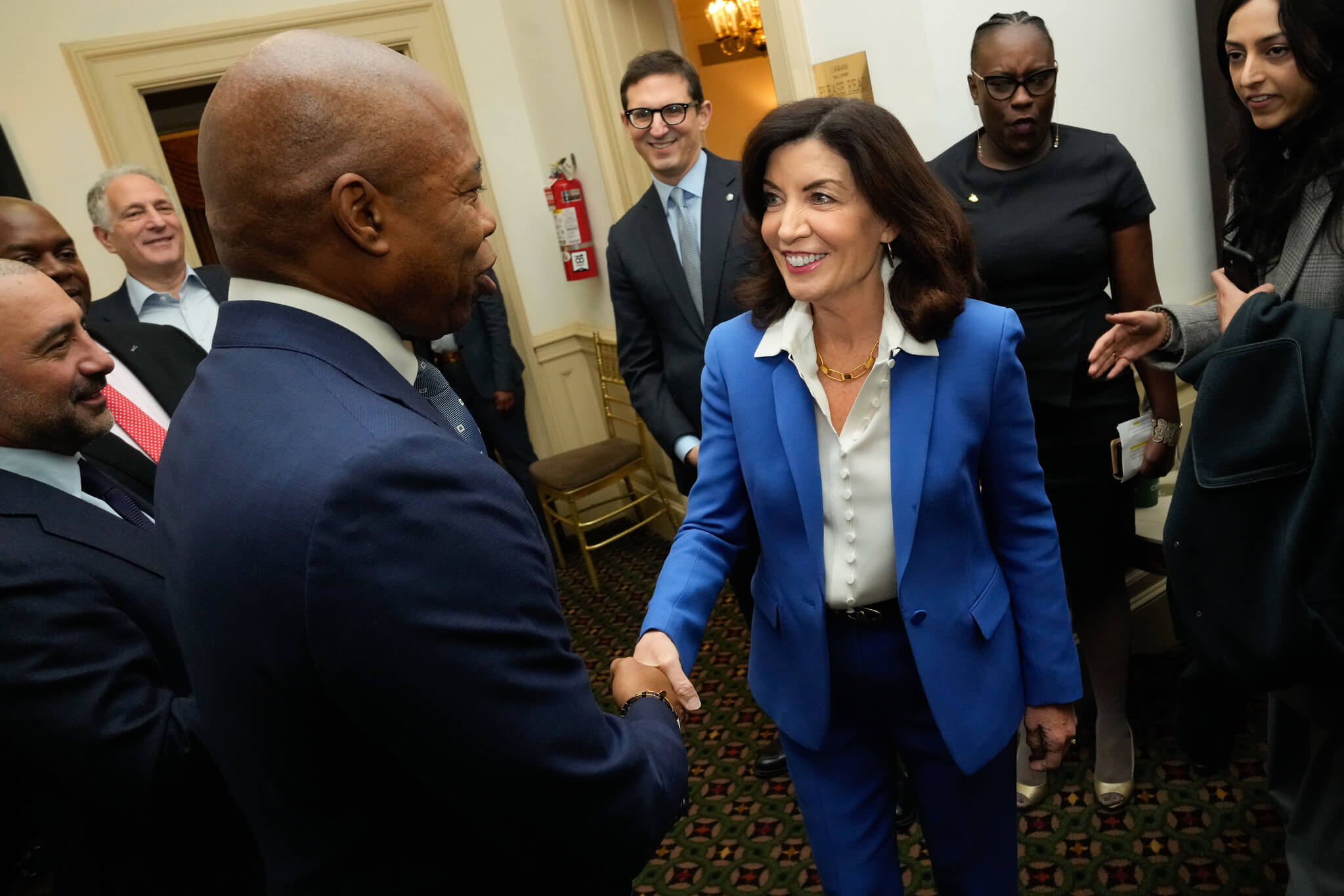Report Recs Major Zoning Changes to Convert Unused Offices Into Housing in NYC
Mayor Eric Adams unveiled a sweeping set of recommendations Monday aimed at converting New York’s underutilized office space into housing, but the cooperation of Albany will be needed to make it happen.

Mayor Adams proposed sweeping zoning changes aimed at converting office space to housing. Photo by Susan De Vries, 2021
Mayor Eric Adams unveiled a sweeping set of recommendations Monday aimed at converting New York’s underutilized office space into housing, but the cooperation of Albany will be needed to make it happen.
The 11 recommendations in the final report from the Office Adaptive Reuse Task Force take aim at two legal behemoths of Big Apple housing policy — the state’s 1929 Multiple Dwelling Law and the city’s 1961 Zoning Resolution.
Most notably, the mayor is calling to relax conversion regulations for office buildings constructed between 1961 and 1990, bringing them in line with more lenient regulations governing edifices built before then. Adams says that alone would open up 120 million square feet of real estate for redevelopment, enough for up to 20,000 homes over the next decade.
The recommendations are the most concrete step yet taken by the city government to convert office space in its business districts — which have been severely underutilized since the Covid-19 pandemic mainstreamed remote work — into homes, as the Big Apple faces a deepening housing affordability crisis and office vacancy sits at an all-time high.
“With this study, we have a roadmap to deliver on a vision for a more vibrant, resilient, prosperous and affordable city,” said the mayor in a statement. “The need for housing is desperate, and the opportunity offered by underused office space is clear — we know what we need to do. These concrete reforms would clear red tape and create the incentives to create the housing we need for New Yorkers at all income levels.”
The timing of the mayor’s announcement is no coincidence: it came one day before Governor Kathy Hochul gave her State of the State address, proposing major initiatives and reforms to spur housing construction and alleviate the affordability crisis.

“Governor Hochul has been vocal about the need to think strategically and creatively to solve New York’s housing crisis,” said Hochul spokesperson Justin Henry. “Last year, she signed legislation to facilitate the conversion of underutilized hotel space into affordable housing and, in December, she stood with Mayor Adams to announce the recommendations of the New New York Panel – which included a proposal to modernize regulations around the conversion of office buildings. The governor will announce her plan to address the statewide housing crisis in her State of the State address.”
Spokespersons for Assembly Speaker Carl Heastie and Senate Majority Leader Andrea Stewart-Cousins did not respond to inquiries by press time.
In their “New New York” proposal last month, the governor and mayor jointly championed zoning reforms to reimagine the city’s underutilized office districts, though that report didn’t get into specifics.
The mayor doesn’t have as much uncertainty to deal with on the city end: Council Speaker Adrienne Adams did not outright endorse the recommendations but portrayed them as the thoughtful conclusion of a process initiated by City Hall.
“Our recovery from the pandemic requires employing concrete tools, flexibility and thoughtful strategies to create homes for New Yorkers and strengthen our central commercial districts,” said Speaker Adams. “I look forward to working with the administration and our state partners to confront the housing shortage, ensuring that New York remains an affordable place to live, work and raise a family for all.”
In Manhattan, office vacancy climbed to an all-time high of 22 percent last fall, and on an average weekday, only 40 percent of workers who filed into offices pre-pandemic were still going into work in person, according to the New New York report.
While the city is swimming in unused or underutilized office space, the situation is very different for housing. Citing stats from the City Planning Department, Hochul tweeted last week that downstate New York has 516,000 fewer housing units than jobs, comparing unfavorably to New Jersey and Connecticut which both have more housing than jobs.
New York is the place where people and businesses want to be. But we need to build more housing to match the jobs we’ve created.
We’re going to take bold action to tackle our housing crisis so that every New Yorker can reach their full potential. pic.twitter.com/iiHUwsUgch
— Governor Kathy Hochul (@GovKathyHochul) January 4, 2023
After a brief period of reduced housing costs during the pandemic, prices have rebounded and then some: rents in Manhattan, Brooklyn and Queens are at or near all-time highs, according to market research by real estate company Douglas Elliman. That’s put the squeeze on New Yorkers already struggling under the boot of inflation.
The mayor’s proposal does not limit its scope to Manhattan: it calls for an additional 16 million square feet of office space to be primed for housing development in smaller business districts as well, like Downtown Flushing and the Hub in the South Bronx, by bringing loosened conversion regulations to districts outside the Manhattan central business district. Back in Manhattan, the report calls for evaluating housing possibilities in the manufacturing districts on the island’s far west side.
The report’s other recommendations include eliminating parking requirements for residential conversions outside Manhattan and loosening regulations on courtyard size, which have snagged hotel-to-home conversions. City leaders, including Adams, had big plans to convert underutilized hotel space into housing, but the opportunity seems to have passed as hotel occupancy recovers to pre-pandemic levels.
Loosening regulations would not mean dropping requirements for light and air but extending existing conversion standards to more buildings, the report says. The report notes an office conversion program could mean lifting the current FAR cap of 12 on residential buildings, which could potentially make New York an even taller city.
The plan comes just weeks after the mayor announced a “moonshot” goal of building 500,000 new homes in the city over the next decade.
Editor’s note: A version of this story originally ran in amNY. Click here to see the original story.
Related Stories
- Landmarked Duffield Street Houses Unexpectedly Sold as DoBro Development Site for $10 Million
- New York City Council Unveils New Land Use and Housing Guidelines
- Pols Debate Barring NYC Landlords From Running Tenant Criminal Background Checks
Email tips@brownstoner.com with further comments, questions or tips. Follow Brownstoner on Twitter and Instagram, and like us on Facebook.





What's Your Take? Leave a Comment